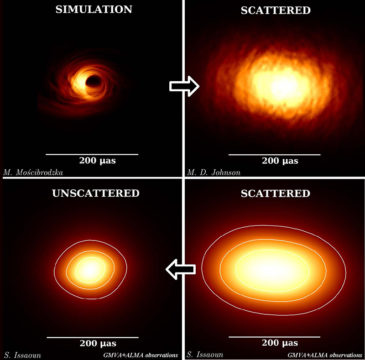Astronomers have overcome the interference of clumpy interstellar gas to catch a glimpse of the gas around the Milky Way’s central black hole.
Radio telescopes working together across the globe have given us a new look at the hot gas around our galaxy’s central black hole, Sagittarius A*. The observations suggest that the compact glow we see is either from a tutu-like accretion disk around Sgr A* or that we’re looking straight down at a jet shooting out from the black hole.

S. Issaoun, M. Mościbrodzka (Radboud University) / M. D. Johnson (CfA)
Sgr A* takes its name from the unusual radio source discovered in 1974 at the black hole’s position in the center of the Milky Way. Radio astronomers have striven for decades to glimpse the structure of this radio-emitting plasma that wreaths the black hole, but clumpy gas lying between us and the black hole scatters photons, obfuscating the image. There’s also the added problem that, at some 26,000 light-years away, Sgr A* is a tiny target — similar to a tennis ball on the Moon as seen from Earth. Only by combining observations from a worldwide network of radio dishes to create a virtual, planet-size telescope are astronomers able to overcome these challenges.
Astronomers are actively working to use such a telescope network to reveal Sgr A*’s silhouette amid the hot plasma enshrouding it. This effort, called the Event Horizon Telescope (EHT) project, is widely expected to announce preliminary results this year.
As complementary work in support of the EHT, Sara Issaoun (Radboud University, The Netherlands) and colleagues have used other, lower-frequency radio observations to map out and subtract the scattering effect from Sgr A*’s glow and produce an image of the gas in this region.
Using observations from 12 radio telescopes in the Northern Hemisphere, coupled with 37 ALMA dishes working in concert in Chile, the team peered deep into the Milky Way’s heart. The resulting data’s high resolution and a technique developed by Michael Johnson (Harvard-Smithsonian Center for Astrophysics) enabled the team to defeat the scattering and reconstruct an image of the black hole’s surroundings.
Admittedly, the reconstructed image doesn’t look like much to the eye: just a glowing circle. But its small size — it spans a distance that’s a mere 12 times the black hole’s radius — and symmetrical shape tell us that we’re looking at gas very close to the black hole, probably either in a disk or a jet seen “down the barrel.”
Up until a few months ago, most astronomers would have thought it highly unlikely that Sgr A* is tilted so severely to our line of sight that we’re essentially looking at the crown of its head. But recent observations with the Gravity instrument on the Very Large Telescope Interferometer also hint that we’re looking down on our black hole.
That viewing angle could be good news for EHT scientists, who might have an easier time teasing out the black hole’s shadow from a top down perspective. Regardless of the orientation, Issaoun’s observations, reported in the January 20th Astrophysical Journal, show that the scattering that has so long stymied studies of our black hole is finally manageable and won’t prevent the EHT’s seminal work.
Reference:
S. Issaoun et al. “The Size, Shape, and Scattering of Sagittarius A* at 86 GHz: First VLBI with ALMA.” Astrophysical Journal. January 20, 2019.
 1
1









Comments
Peter Hornby
January 24, 2019 at 2:50 am
Are there any theoretical predictions for the preferred orientation of the rotation axis of a galactic black hole. A naive argument might be to wonder whether the rotation axis might be parallel to the overall rotation axis of the galaxy, in which case it would be more or less perpendicular to the line of sight from our position in the galactic disc.
You must be logged in to post a comment.
You must be logged in to post a comment.